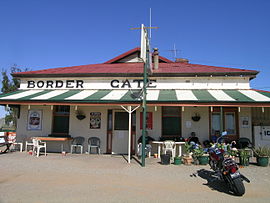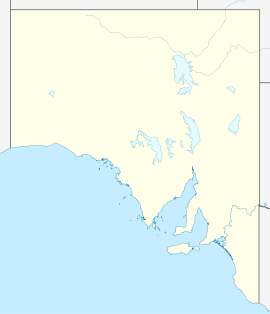- Cockburn, South Australia
-
Cockburn
South Australia
The Border Gate Hotel, CockburnPopulation: 90 (2006)[1] Established: 1885 Postcode: 5440 Elevation: 213 m (699 ft) Location: - 462.2 km (287 mi) NE of Adelaide
- 50.4 km (31 mi) W of Broken Hill
Cockburn (pronounced /ˈkoʊkbɚn/ is a town on the border of South Australia and New South Wales near Broken Hill. The town population consists of roughly 25 people with a greater regional community of 180 as of 2005.
Town history
Huge ore deposits were discovered in Silverton, which prompted the South Australian Government in 1884 to offer to the New South Wales (NSW) Government the building of a narrow gauge railway line from the NSW-SA border to Silverton. This was seen to be necessary since horse drawn transport could not cope with the transport of the ore through South Australia. This offer was rejected by the NSW Government.
Local business people therefore formed the Silverton Tramway in 1885 to build the railway line from Silverton to the SA border. The town of Cockburn came into existence in 1886 (on the SA Side of the border) as a place where trains would exchange locomotives and crews. On the NSW side of the border the Silverton Tramway Company built a station and siding called Burns.
The pressure for the expansion of Cockburn was increased with mineral discoveries at Thackaringa and Umberumberka from 1883 onwards. The silver-lead-zinc discovery at Broken Hill led to the railway line being extended from Silverton to Broken Hill in 1887. The route was extremely important as it provided balanced trading for locomotives with a momentum grade 'up' from Broken Hill to Cockburn and a rising grade 'down' from Cockburn to Broken Hill. This was the main advantage of the route to and from Cockburn.
By 1892 the town of Cockburn had become sizable. The population was 2,000 people. Cockburn boasted two hotels, two general stores, three boarding houses, schools and churches. It contained within its business sector a blacksmith, butcher, baker, produce merchant and carrier. Stationed at Cockburn included two engineers, a stationmaster, customs officer, locomotive superintendent and a miner. Locomotive shed and related work facilities were recorded as existing in 1892. Seven trains regularly ran between Petersburg (now Peterborough), Cockburn and Broken Hill. These included passenger trains. In 1892, 83,194 passengers travelled through Cockburn.
Cockburn also has a role in industrial relations history in Broken Hill. Tom Mann, a political "disruptionist" was barred from speaking publicly in New South Wales. In 1908 3,000 passengers came from Broken Hill to Cockburn to hear Tom Mann speak. From the front of the hall next to the Cockburn Hotel he addressed the crowd, which was the beginning of a dispute known as the 1909 Lockout. During this dispute Broken Hill mining unionists were locked out of the company gates for rejecting pay cuts which would have been below the minimum wage.[2]
The standard gauge railway line, officially opened in 1970, runs south of the surveyed town limits of Cockburn, and has a new station and a passing loop. The "new" station is now disused.
In the early 1990s the South Australian Government proposed to close down the small communities along the Barrier Highway leading to a strong and unified resistance from the local communities. In April 2006, the government planned to demolish five former railway houses [1].
References
- ^ Population 2006 Census Australian Bureau of Statistics
- ^ "2009 marks centenary of Broken Hill's BHP union Lockout". ABD Rural. http://www.abc.net.au/rural/content/2008/s2506948.htm. Retrieved 19 May 2011.
External links
Central North West Region East and North East Region Far North Flinders Ranges Gawler Ranges and Far West Ash · Bookabie · Border Village · Coorabie · Fowlers Bay · Gawler Ranges · Iron Knob · Penong · MintabieCategories:- Towns in South Australia
- Borders of South Australia
- Borders of New South Wales
Wikimedia Foundation. 2010.

